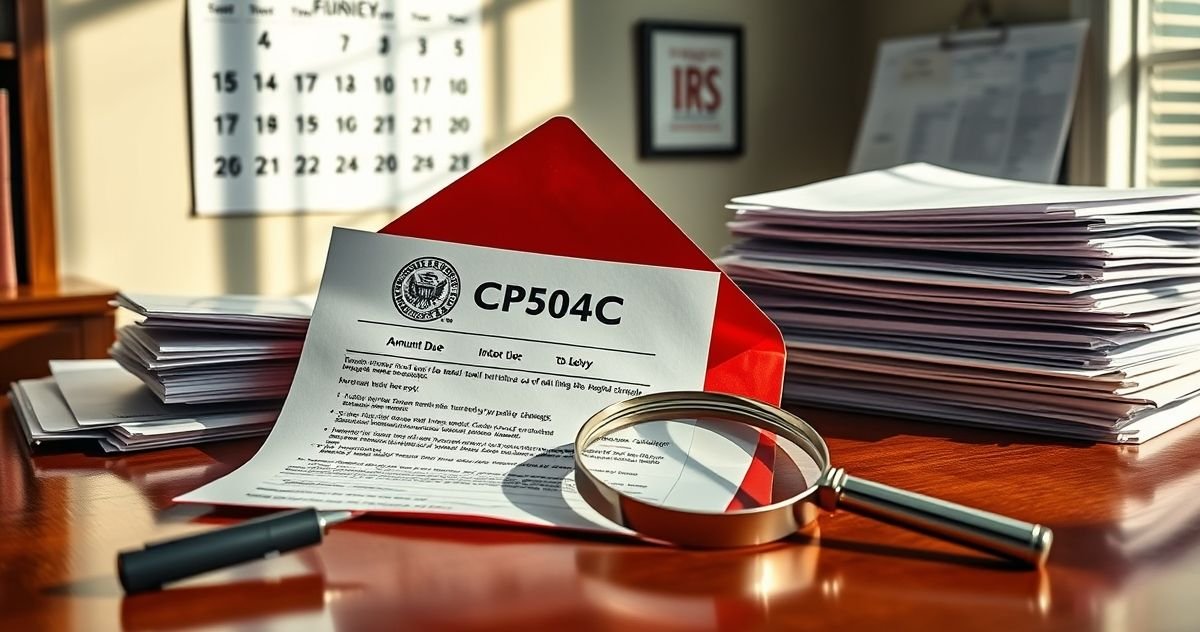Understanding the CP504C Notice from the IRS
The CP504C Notice is a formal communication issued by the Internal Revenue Service (IRS) primarily intended to inform taxpayers of impending enforcement actions related to outstanding tax liabilities. When you receive a CP504C Notice, it essentially means the IRS is raising a red flag about unpaid taxes, and failure to respond promptly could lead to more severe consequences, such as liens or levies on your property.
Purpose of the CP504C Notice
The core purpose of the CP504C Notice is to serve as a final reminder of your tax debt and the potential enforcement actions that may follow if the debt is not addressed. While the notice itself is not the start of IRS collection efforts, it indicates that prior notices or demands have likely been neglected. This particular notice is part of the IRS’s collection process and is typically sent after you have ignored previous requests to settle your tax debt.
Key Features of the CP504C Notice
- Notification of Intention to Levy: The CP504C Notice informs the recipient of the IRS’s intent to levy, meaning they may seize property or assets to satisfy the debt. While the IRS does not initiate a levy with this notice, it’s a critical warning.
- Amount Due: The notice will specify the exact amount you owe, including taxable interest and penalties accrued since the original amount was due.
- Instructions for Payment: The notice provides detailed instructions on how to pay the owed amount, including options for check payments or online transactions, to help the taxpayer resolve their debt expediently.
- IRS Contact Information: Essential contact details and hours of operation are provided, offering recipients resources to seek assistance or clarification regarding the notice and their tax obligations.
Compliance and Filing Requirements
Upon receiving a CP504C Notice, it’s crucial to act immediately. The notice itself will provide a deadline for making the payment or reaching an agreement with the IRS, such as an installment plan or offer in compromise. If you believe the notice was sent in error, you must contact the IRS promptly to avoid any unwarranted penalties or further action.
Penalties for Non-Compliance
Ignoring the CP504C Notice can lead to severe repercussions. Initially, you may face additional late fees and interest rates, increasing the total amount due. More importantly, if the notice is disregarded, the IRS has the authority to enforce collection actions. These actions can include:
- Tax Levy: The IRS may levy, or legally seize, your property to offset your overdue taxes. Common targets include bank accounts, wages, or other personal property.
- Tax Lien: A federal tax lien is another serious step, whereby the IRS makes a claim to your assets in the public records, potentially affecting your credit rating and ability to sell assets.
- Loss of Tax Refunds: Future tax refunds may be withheld and applied to your debt until it is fully resolved.
Importance of the CP504C Notice in Tax Resolution
The CP504C Notice plays a crucial role in the IRS’s collection framework and serves as an opportunity for taxpayers to rectify mistakes before more drastic measures are taken. It signals the seriousness of the tax debt situation and proffers a final chance to negotiate or settle the debt.
By taking immediate action in response to the CP504C Notice, taxpayers can avoid further damage to their credit, prevent the loss of or liens against possessions, and potentially access helpful IRS programs designed to assist those who are unable to pay their taxes in full.
How to Respond to a CP504C Notice
Upon receipt of this notice, taxpayers should meticulously review the details to ensure the accuracy of the recorded debt. If the amount appears incorrect or if you disagree with the notice, it’s critical to contact the IRS as soon as possible. Providing necessary documentation or seeking professional tax advice from a qualified advisor can streamline this process and help resolve any discrepancies.
For those unable to pay the full amount, establishing a payment plan or requesting an offer in compromise are viable options. The IRS website provides a host of resources and forms designed to aid in negotiating feasible payment terms.
Additionally, staying compliant with future tax filing and payment deadlines is essential to avoid similar issues in the future. This includes maintaining accurate records and seeking professional advice for complex tax situations.
Conclusion
The CP504C Notice is a vital element in the tax compliance ecosystem, acting as both a warning and a tool for resolving outstanding tax issues. Recognizing the notice’s significance and taking prompt, appropriate action can preserve both financial health and legal standing with the IRS, ensuring taxpayers avoid further complications or enforcement actions.

